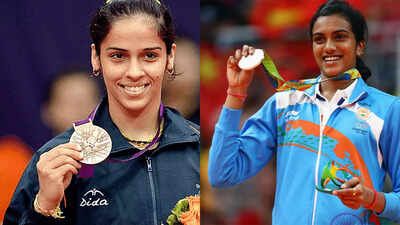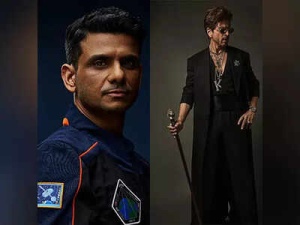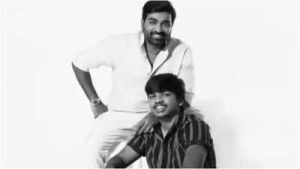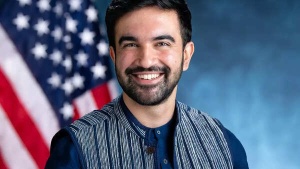After a period of unprecedented success led by Saina Nehwal and PV Sindhu, Indian badminton is currently experiencing a significant downturn. The sport, which had carved out a prominent space in India's sporting landscape, is now struggling to maintain its momentum.

Saina Nehwal and PV Sindhu, iconic figures of Indian badminton
Recent poor performances have raised concerns, and the lack of promising successors to build upon the achievements of Nehwal and Sindhu paints a concerning picture for the future. While Saina Nehwal, a trailblazer, is now 35, the 29-year-old PV Sindhu, a two-time Olympic medalist, is facing challenges in the early stages of tournaments.
From securing three women's singles medals in consecutive Olympics to achieving the pinnacle of men's badminton by winning the Thomas Cup in 2022 and the first Asian Games men's doubles gold in 2023, Indian shuttlers have experienced a remarkable rise. However, the current situation, with no players reaching the semifinals of the All England in 2025, represents a significant decline.
Apart from Satwiksairaj Rankireddy and Chirag Shetty, and to some extent Lakshya Sen, the performance of other Indian players has been underwhelming. The era when players like Saina Nehwal, PV Sindhu, Kidambi Srikanth, Sai Praneeth, HS Prannoy, and Satwik-Chirag were considered favorites in tournaments seems like a distant memory.
This decline has been evident for some time. Since HS Prannoy’s Malaysia Open Super-500 title in January 2023, Indian players have struggled to win singles titles. Only the doubles duo of Satwik-Chirag have managed to secure a few victories. In April of this year, India's performance at the Sudirman Cup was particularly disappointing, as they were eliminated in the group stage after losing to Denmark and Indonesia with identical scores of 1-4.
The past decade was a promising period for Indian badminton. Following Saina Nehwal’s Olympic bronze at the London Games, PV Sindhu emerged with a bronze at the World Championships in 2013. Alongside Saina and Sindhu, players like Parupalli Kashyap, Kidambi Srikanth, Prannoy, and B Sai Praneeth gained recognition in the men's category. Srikanth even reached the World No. 1 ranking and won four Super Series titles in 2017.
In 2019, Sindhu became the world champion, and Sai Praneeth won a bronze at the World Championships. In May, Srikanth showed glimpses of his former form by reaching the final of the Malaysia Masters. However, his low ranking prevented him from participating in subsequent tournaments.
Satwik-Chirag made their mark in men’s doubles, particularly at the Commonwealth Games. However, they have also faced fitness challenges and have yet to reach a final this year. Currently, Lakshya Sen carries the responsibility of leading the men’s singles challenge. Despite his potential, including reaching the All England final and winning a bronze at the Worlds, he has only won two Super-500 titles. The wait for a Super-750 or Super-1000 title continues. Beyond Lakshya, there is a lack of players at the level of Srikanth or Prannoy.
The situation in women’s singles is even more concerning. There is no clear contender to lead the Indian challenge. While Saina and Sindhu have set high standards, the younger players have not yet reached their level. Malvika Bansod, Aakarshi Kashyap, Unnati Hooda, Anmol Kharb, Tanvi Patri, and others are attempting to fill the void, but without significant success.
When Pullela Gopichand became the chief coach of the Indian team in 2006, he aimed to transform it into a formidable force. At that time, no Indian player was in the top 10, and only a few were in the top 100. Gopichand achieved his first major success at the Commonwealth Games in 2010. A significant milestone was Saina Nehwal’s badminton medal at the London Olympics in 2012. With Sindhu’s emergence, Indian badminton was on an upward trajectory until it encountered obstacles.
One factor contributing to the decline is the reliance on a golden generation of players. As with most successful generations, their replacements often struggle to maintain the same level of performance. Unlike countries like China or Malaysia, India lacks a well-structured system for consistently producing high-level players. There has been no dedicated talent-search program to identify and nurture potential players. While Saina and Sindhu have inspired many youngsters to take up badminton, there is a shortage of qualified coaches to train them. As the number of players increased, the existing coaches were not adequately trained to meet the growing demand.
If a core group of emerging players had been identified and developed, dividing them into elite and developing groups to foster competition, the current situation might be different. Players like Malvika, Aakarshi, Tanvi, and others could have been trained more effectively under one umbrella. However, due to short-sightedness, such initiatives were not implemented, widening the gap between elite and emerging players. While international players continued to compete at the highest level, the second-string players suffered from a lack of competition. Even now, efforts to bridge this gap are limited.
Despite potential disagreements from the national association, there is a clear lack of support for promising junior and sub-junior players across the country. Badminton Association of India (BAI) secretary Sanjay Mishra acknowledged that progress has not met expectations.
“Undoubtedly our performances suffered a setback due to injuries to key players. However, transition of the next generation also requires time to strengthen and sustain our competitive edge,” Mishra told TOI.
“BAI is focused on enhancing coaching, injury management and talent development to ensure long-term excellence. While we are committed to building a strong ecosystem for global success, we must acknowledge that progress takes time,” he added. “At the National Centre of Excellence, under the guidance of Olympic medallist coach Ivan Sozonov and coach Park, we are focused on nurturing the next generation of champions along with other academies in Hyderabad and Bengaluru.”
The former junior national coach expressed optimism about the future. “A notable number of junior players are already ranked in the top 10, the intensity of competition at domestic events reflects the rising calibre of emerging talents. Players are challenging and even surpassing established champions. With a growing talent pool and focus on structured coaching, we are confident of a strong future in Indian badminton,” Mishra said.
At its recent annual general meeting (AGM), BAI unveiled a Rs 9.75-crore annual plan to drive the growth of badminton. While the plan includes several interesting provisions, more emphasis should be placed on developing coaches.
“There should be three categories of coaches. The first category for identifying nascent talent and grooming them. The second should see them through their formative years and send them to national camps when they reach 12-14 years. At the third stage, well-trained coaches should nurture them and turn them into international talents. Nothing of this is happening,” a source said.
BAI has allocated funds to offer monthly retainership to Olympians and former international players who are now training players at national camps. However, it remains uncertain whether their experience will be sufficient to produce the next Saina and Sindhu. There is a long-term need for trained coaches, and talent identification and development should be prioritized. More trained coaches should be selected, and comprehensive programs should be established.
While BAI cannot change past results, it can implement a proper system with a clear three to five-year plan to improve Indian badminton’s standing. The association and coaches should collaborate to determine the tournament schedule for top shuttlers, especially during Olympic and Asian Games years. Many veteran players and administrators believe that a plan similar to the one implemented by Pullela Gopichand should be adopted nationwide. If one academy can produce so many champions, why can’t others emerge from different parts of the country? There is no shortage of talent, but a proper system must be implemented promptly to prevent Indian badminton from becoming mediocre.
Newer articles
Older articles
 India Enters New Space Age as Astronaut Shukla Joins ISS Mission
India Enters New Space Age as Astronaut Shukla Joins ISS Mission
 X Cracks Down: Half a Million Indian Accounts Suspended for Policy Breaches
X Cracks Down: Half a Million Indian Accounts Suspended for Policy Breaches
 Google Unveils Strategy to Combat Misinformation, Boost Voter Access in India's 2024 Elections
Google Unveils Strategy to Combat Misinformation, Boost Voter Access in India's 2024 Elections
 Hair Oil vs. Hair Serum: Which is the Right Choice for Your Hair?
Alternatively:
Unlock Your Best Hair: Choosing Between Hair Oil and Serum for a Healthy Mane
Hair Oil vs. Hair Serum: Which is the Right Choice for Your Hair?
Alternatively:
Unlock Your Best Hair: Choosing Between Hair Oil and Serum for a Healthy Mane
 Bollywood's 'Swades' Anthem Joins Axiom-4 Mission: Indian Astronaut's Playlist Honors Heritage in Space
Bollywood's 'Swades' Anthem Joins Axiom-4 Mission: Indian Astronaut's Playlist Honors Heritage in Space
 Vijay Sethupathi Apologizes Amid Controversy Over Son's Film 'Phoenix'
Vijay Sethupathi Apologizes Amid Controversy Over Son's Film 'Phoenix'
 New York Assemblyman Zohran Mamdani's Style: 5 Lessons in Authenticity and Heritage
New York Assemblyman Zohran Mamdani's Style: 5 Lessons in Authenticity and Heritage
 Colon Cancer: Don't Ignore These 5 Early Warning Signs
Colon Cancer: Don't Ignore These 5 Early Warning Signs
 TSMC Regains Top 10 Global Value Ranking Amid AI Boom
TSMC Regains Top 10 Global Value Ranking Amid AI Boom
 Android Users Urged to Update Devices Amid High-Severity Security Flaws: Government Issues Warning
Android Users Urged to Update Devices Amid High-Severity Security Flaws: Government Issues Warning